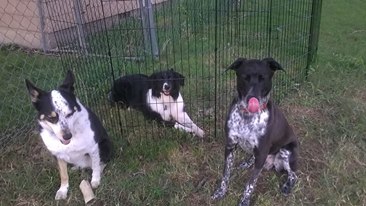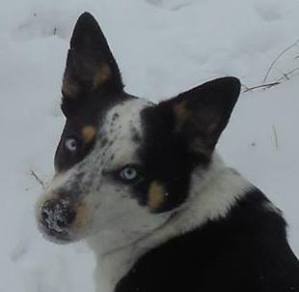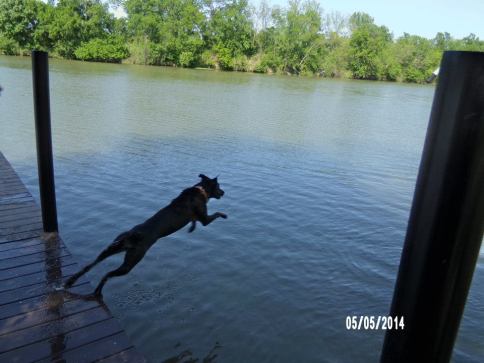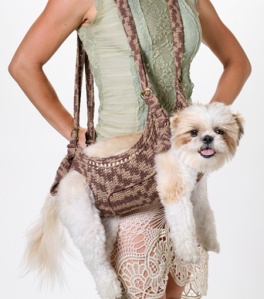A Dog, By Any Other Breed

I believe in dog karma.
What that means is, if I see a loose dog, I stop and call them, and try to gather them up so they aren’t hurt.
I should hope that others would do the same for mine were they lost.
Of the ten or so dogs I succesfully gathered this way, only two ever went home. The rest nobody was looking for, so I found them new ones.
This dog was on my street for four days. Ran every time I casually approached, tail tucked, ribby, frightened. He had a collar though. Most of them that run away do, and I never see them again. The city eats them.
This guy kept coming back. White male American pit bull terrier, classic lines, black mask and ticking.
It’s fate, I figure, when I can’t catch them.
But he kept showing up.
One day, I see him resting in the grass of an empty house. He is exhausted, sleeping in the middle of the day when it’s finally warm. Stomach twisting, hesitating, I think (well, one more time. But he’s a pit.) I don’t hesitate to try and gather up the other dogs. But he’s a pit.
But he’s a pit! What breedism! What prejudice! Why should I even think that? What a monster!
Let me be honest with you. Pit bulls are like soda cans in this town. There are a million of them ghosting through the streets. Most of them I never even get close to before they disappear. They are insanely difficult to place responsibly, and about a quarter of them are wired for dog aggression because we have a thriving illegal fighting community here in Oklahoma that continues to contribute strongly to the population at large. Nobody here wants pits, and the people that do are often . . . questionable. “Dime a dozen.” Some have said. “Trash dogs.” Some have said, more quietly.
But I couldn’t leave him there to get hit by a car or die of infection or disease. He’s still a dog.
I went to go sit by him on the grass.
He sighed, gave me a look of total exhaustion, then came for a treat and let me clip a leash on his collar.
A week later, no hits on his found ads. No hits on the flyers. No offers of “oh, I’ll take him if you don’t find his home!” Either. Just a bunch of nothing, some empty congratulatory words on how I’m an “Angel” for helping him, and the knowledge that yes, he’s at best dog selective because he really despises one of the board and train dogs through his crate bars (though she may, admittedly, deserve it).
Which means he represents significant liability if I place him with another dog and they go at it. Because he’s a pit. Which means if I fail in my management at home, he could take out one of my dogs, though he’s stopped any tomfoolery at the crate door I know that potential is still there.
And he is, of course, wonderfully behaved otherwise, quiet, housetrained, friendly and wiggly and enthusiastic and resilient and not body sensitive and pathetically grateful for food, shelter, affection, and training. He is bright, sweet, and eager.
He is a perfectly sensible, normal dog.
But he’s a pit.
I don’t know what I’m going to do.
How to Spot a Pro

As the holidays draw near, I keep seeing more and more evidence of everyday normal folks getting pulled into using unprofessional people for dog services – whether it be training, boarding, dog sitting or walking, or anything.
Just because somebody has fancy letters after their name, a website, a business card, or even a location (and sometimes even good reviews) doesn’t mean diddly squat about their qualifications. And, perfectly competent dog folks come from every spectrum of the rainbow and in 1/10 instances even if they have various philosophies you might hit somebody who can really help you out.
So how can you tell a good dog professional from a bad one?
1) Their dogs
The dog professional should have their own dogs (if they don’t, please run away quickly). Somebody committed to the craft will make a way to keep dogs, even if it’s just one. If they don’t have dogs, you can’t tell what kind of dogs they produce. Look at their dogs – are they healthy? Not fat, coat in good condition (unless they are anciently old), nails trimmed, teeth in good order? Are the dogs “cool” – calm, collected, generally either friendly or aloof and under control? If the dogs are frantic and out of control, do you want somebody who can’t control their own dogs trying to work with yours? Is their whole household a big chaotic swirling mess of dogs without any order? You want somebody who can be calm, and orderly, and controlled with dogs, and if they can’t do that with their own, they can’t do it with yours.
2) Their handling of your dog
Can they handle your dog, even if it isn’t trained? Do they make your dog feel awkward or uncomfortable by getting into their space rudely? Are they “syrupy” to the dog excessively? (which is a dead ringer for somebody who is at best a passionate amateur and NOT a professional) If they let your dog jump all over them, drag them around on the leash, drag them out the door and generally treat them rudely, how can you trust this person to have the handling skills to prevent your dog from jerking the leash from their hands and running away, or shoving them out of the way and running out the front door? You want somebody who has handling skills – confident, cool, and in control of the situation even if your dog needs . . . well . . . work!
3) Their Perceptiveness
Finally, professional dog people watch dogs. They watch them, maybe not obviously, but all the time. They have excellent situational awareness and are perceptive about what the dog is doing to an almost paranoid level. Even when you are conversing with them, don’t be insulted if they drop the middle of a sentence or don’t make eye contact because they are watching the dog – that’s a GOOD thing. They are aware of other people in relation to your dog, to other dogs in relation to your dog, to what your dog is doing and how the situation feels. They step in if the feel the situation isn’t in control, and pay attention to what is going on around them. If a boarding facility employs eighteen year old girls with Iphones glued to their faces, don’t use them. Dogs die in the space where people aren’t paying attention to what’s going on.
It’s not that hard to spot a true professional, and as much as we love our family and friends, most of them aren’t true professionals. If you want your dog to be safe in the hands of another person, use somebody who is really invested in knowing dogs, and knowing how to house and work them safely.
After all, saving some money on boarding or training doesn’t make a bit of difference once your dog bolts out your mother in law’s front door and gets hit by a car, or strangles themselves overnight on a cobbled-together kennel in a nonprofessional boarding facility that has undertrained, noninvested staff, or gets ripped to shreds by daycare dogs in a facility run by somebody who “just LOVES doggies”.
Protect yourself. Protect your dog. It’s your duty.
Some Dogs Won’t Hunt
As a trainer, I see a lot of dogs that work, and do amazing things, for their owners.
And I see just as many dogs that just don’t fit in their homes. Their energy levels are too high (or too low, rarely), they are working dog types in a home with people who don’t want to work the dog. The dog isn’t patient enough with a handler who is a novice. The handler isn’t patient enough with a dog that is a puppy.
Often, I can fix these issues and the handler and the dog are happy, healthy, and continue on forever happy, with just a little bit of assistance and tweaking.
Rarely, the pieces just still don’t fall into place, and even after hard work you can see the dog and the handler still aren’t happy with one another.
And this is where the concept of the “Forever Home” fails dog owners miserably – because ultimately, what happens is that in these few cases where the owner has tried to seek assistance and is simply outdogged (the dog is too large, or too smart, or too energetic to do well in their lifestyle), often the owner will cling, with great guilt, to the idea that they “committed” to this dog and must push on through, no matter how miserable they are.
Granted, I’m not advocating just dumping a dog that is inconvenient – though rescues, shelters, and breeders alike frequently fail their clients by selling them an inappropriate dog.
But ultimately, the welfare of the dog must be paramount – why continue living a life fighting to make two pieces fit that just . . . don’t?
Working dog people do not make this mistake – a dog that will not herd is placed in a pet family, or an agility family.
And some dogs just won’t hunt.
And that’s ok – the working person simply places the dog elsewhere, in a home where the dog can ‘fit’.
I find myself advocating, in the rare cases, that pet people do the same. After all, the dog has a job – to be your pet – and if after some hammering, and some work, the dog still can’t cut it, then both parties would be more relieved to go their separate ways.
After all, just like any relationship, sometimes it’s better that way.
“Sickening”
Apparently, the rescue world has become so weird that even if you find a stray dog, do your due diligence to locate the owner with flyers, contacts, internet postings, etc. and cannot; foster the dog under your care without compensation, and interview and vet multiple adopters in an effort to find this stray dog a home, it’s still sickening because dog rehoming can only be done by “reputable rescue shelters”.
Sentiment keeps skewing to where the only people who have moral permission to interact with dogs are shelters and rescues, even to the point of those entities breeding dogs despite continuing narrative of pet overpopulation.
I have found, fostered, and adopted out four strays in the past three years, all after two weeks of advertising widely to find their owners without response. The effort to find a lost dog has to be reciprocal, and people who really want their dogs back make very, very certain to look very, very hard for them.
Those dedicated folks in rescue that I know and love desperately want to keep dogs OUT of the rescue and shelter system. Rescues are often full to the brim with a waiting list to take dogs on, and shelters move so much volume that they can’t vet adopters and often have to put dogs without an immediate adoption down. I have people contacting me constantly as a trainer to take dogs that need to be rehomed – and I do my best to teach them how to foster, screen, and adopt dogs themselves.
Because keeping a dog out of the shelter and moving them to a new home is best done by the individual, not by an overtaxed – if “official”- system.
What Role, the Dog?

The girls gang up on Dax playing in the yard. He does appeasement behaviors to deal with it, but I’ve had to step in and stop them from heckling him too badly.
I read a lot of articles about “leadership” in dog training. They have a lot of rules, and dos and don’ts, and depending on which tribal camp the author comes from emphasize heavily some woo-woo things about energy or some equally woo-woo things about positive reinforcement.
I’d like to write a different list about how to be a leader to your dog. It’s a lot shorter than most of the other lists I’ve seen.
1) Be Willing To Take A Bullet
I was cycling with Mika towards the nearby campus one light, fluffy spring day, when I saw an offlead dog charging towards us. You can predict from stories of woe and horror that you’ve seen on the internet that loose dogs are a problem. I’ve heard stories of packs of dogs taking down even a healthy and cognizant person, when out on a walk with their dogs. I’ve gotten calls from clients who have – not once – but twice been attacked by large, maurading dogs (one instance where a mastiff broke through a fence to get to them) in their own neighborhood.
So what did I do?
I got off my bike before the dog could get to me, unhooked Mika, put her in a sit-stay (downstays are too vulnerable for my liking in such situations) and threw the bike at the dog.
The bike hit the dog with a resounding “AEIP!” and the dog, predictably, ran off from the crazy bicycle throwing person never to bother us again. My bike, being a sturdy mountain bike, took no damage at all.
Now, this is a more obvious situation of being willing to do anything to protect your dog – momma-bear fashion – but people don’t realise that they don’t protect their dogs from anything. They let strange people and dogs assault theirs. They talk on their cells while walking the dog – completely obliterating your situational awareness. And like the client mentioned above, they continue to expose their dog to dangerous areas and situations even after the worst has already occurred once.
They put their dogs into offleash play situations with dogs who either gang up on their dog, or who are so large and rowdy that they overwhelm their dog, and then don’t bother to stop it when their dog is being persecuted. They put their dog offlead before the dog has the requisite reliability to be called off of (deer, rabbits, other dogs, people, squirrels, whatever).
It is your duty and trust to protect your dog. That is what a leader does – protect their people. Now, that doesn’t mean bubblewrapping them from every situation, no – because to protect your dog you also must push them to develop the temperamental resilience to deal with stress (something that is glaringly lacking in many positive reinforcement training regimens).
So walk softly with your dog and carry a big stick. And be willing to use it, too.
2) Don’t Let Them Push You Around
Probably one of the most dominant things you can do to your dog is ignore them. When I see clients coming in for training the first time, the thing they all do is continually pet and manhandle their dogs – and their dogs continually pester them.
If your dog is pestering you – don’t respond. If they’re barking, either don’t respond or they get a response that isn’t what they want. If they’re poking prodding, nudging, staring, whatever – this is the sign of a dog that doesn’t respect your physical person or your social presence. So the most regal, leaderly thing to do is simply to not give them the pleasure of getting something out of you. Be immovable, immutable. Most nasty, aggressive dogs start out simply being pests and getting what they want by pestering you.
Leaders change their follower’s behavior, not the other way around – and if you dog fails to do that, then suddenly the roles are reversed.
3) Be Consistent
You have to be consistent about this, though, because dogs are the masters of manipulation – if you are a waffler, your dog will grab ahold of that tooth and nail and they will use it to advance themselves in the social hierarchy.
After all, somebody who is only offering guidance, protection,and clear rules some of the time is almost worse than somebody who never does it. If you decide that your dog is no longer allowed on the couch, then you’d better be willing to follow through with it.
Nobody respects a flip-flopper – and it makes you look like a crazy person to your dog.
And that’s it.
That’s all. And none of this stuff is new – trainers since the beginning of time have been using these three rules, though some people make it seem more complicated than it really is.
The Wolf Inside
Mika didn’t come inside when I called her.
It was late, and I had just arrived home – normally she’s there to greet me (sometimes by dancing on the table).
I went outside to make sure nothing awry was afoot, to find her hunched over a partially devoured rabbit corpse, blood smeared muzzle black in the moonlight, blue eyes gleaming, prick ears at half mast. She bolted a few more chunks of rabbit hind leg, convulsively, then stepped back as I approached, eyeing the rabbit warily. Not much left past a cute little head.
“Hm. Good job, kid.” I casually picked up the cute little head and tossed it in a plastic sack to go out in the garbage.
Now Mika seems like a civilized dog by all accounts. She’s clean and neat and polite, intelligent and skilled, useful and helpful and utterly responsible around pet birds and small children. She pointedly ignores prey when we’re working, allows me to brush her teeth and trim her nails to manicured perfection.
She’s also a bloodthirsty, mud-rolling, bitch-fighting, rabbit murdering savage. I have seen her after epic battles with the large male squirrels, muzzle slashed and bleeding and eyes wild with joy.
In that, dogs are like us – the thing that I love most about them is that on a full moon night, I go out in the forest with my dogs in the cold and the blue shadows, and with them I can hear that old call of the wild. A lot of people look at dogs and see them as creatures of pure love and joy, beings of light and total innocence.
And dogs are sweet – but they are far from pure innocence. All of my dogs are complicated creatures. Mika understands well that some people are weak, and she has contempt for them. She manipulates, she pushes, she tests. I became a trainer because she was going to eat my lunch if I didn’t.
And truth be told, she’s far from entirely civilized – and that’s not a bad thing. After all, I have a wolf inside, too. Perhaps that’s why we get along so well.
A Thought about Death, Dogs, and Working Snobs
I had occasion recently to consider what should be the fate of dogs if their trainer dies.
Dogs are a craft, almost a religion, to trainers. We put thousands hours of hard work, and so many countless heartaches and long nights contemplating ethics, strategies, and learning with our dogs and ourselves. I put it the other day that Mika is my “fifth limb” – and it’s true.
So what happens if you died, unexpectedly?
Do you let the dog stay with your family? Most of us don’t have a family full of Dog People. Likely, the dog would become an average couch potato house pet at that point because frankly most families aren’t set up to continue working a true working dog – something that is close to blasphemy in the eyes of a working dog trainer. It’s a first impulse to say “no, never, I would want them to be placed in a working household, and continue on being a trainer’s right hand someplace.”
But then, would it be like they are losing their entire pack to do so? What would that do to your family to take your Fifth Limb from them?
What if the family turned the dog – not necessarily into a working dog – but into an active household pet that still had fulfilling activities and discipline that would keep the dog in good health and mental wellbeing? Does the dog know the difference between work that wins ribbons and accolades, and a good long hike and being a household helper?
In the case of a service dog, would it be hubris to keep a dog that could provide that much help – potentially lifesaving help – to somebody else in need if it were placed as a service dog with another person?
I don’t know.
What A Service Dog Takes
We get a LOT of calls about service dogs.
A LOT. As in, upwards of twenty a day.
So, why aren’t we full up to the brim with people, and a waiting list ten miles long?
Because 99% of the people inquiring about service dogs don’t know what it takes to produce one, maintain one, and own one.
1) Commitment.
This is the heavy hitter. It’s not readily apparent, but a service dog is life-changing. Some of those changes are extremely positive, as the dog does its tasks, and life saving in some instances. Some are just changes, that can be uncomfortable – public attention when you’re travelling anywhere with your service dog, Having to house and feed a dog. Having to maintain its training – which includes sometimes radical reassessments of life philosophy as well as some pretty significant lifestyle changes. If you don’t commit to these things, then you end up with a very expensive pet.
There’s also a huge commitment on the part of the service dog organization – when you contact us about a service dog and say that you are going to commit to one, immediately we begin networking to find the right dog for you, juggling logistics to figure out which trainer can take the dog, fosters for the dog, a training plan for the dog, how to raise immediate funds to secure this dog for you, working with rescues, individuals, shelters out of state, trainers out of state, establishing alliances with breeders and professionals across thousands of miles to get you your dog – basically there is a massive upheaval of effort initially to work towards your dog, even before you ever see it. This process requires thousands of man-hours and quite a bit of money to even begin.
2) Time
Speaking of which, there is a huge time commitment. Not only do our trainers field thousands of hours of inquiry calls, plus the time to find, vet, obtain, and place in a foster a dog, there’s the time of training. A reputable trainer working full time as a trainer (and our SD trainers work part-time out of financial necessity) takes about three weeks per task to establish that task in the dog’s learning repetoire, and then another month or two proofing that task in all environments (though proofing usually cycles through all tasks).
This is somewhat variable – for example, a hearing dog alerting on a weather radio, cell phone, and home phone will take three weeks for the first, two weeks for the second, and a week for the last because those tasks are very similar – but they are still seperate tasks. When you’re talking about very difficult tasks that a dog doesn’t have a lot of innate skill in – force fetch for example – it can take a month to truly establish that skill on the dog in any meaningful and useful way. Some dogs also pick things up faster than others, or slower, depending on their personality and background.
In addition to that is proofing the dog’s temperament and obedience, which must be absolutely stellar. It can take up to a year on a young untrained dog to have their obedience truly rock-solid and their public access smooth. Our organization manages to expedite this by preferentially choosing dogs that are mature (or close to it) so that we don’t have to start them as puppies (another year if we start with a puppy), but that also means we must fix any minimal hangups that they come with.
3) Training
Training doesn’t stop after the service dog comes home. This is the part that’s very difficult for some – a service dog is a working dog. They aren’t a pet – that means they don’t get to do whatever they want, dig holes in the yard, pee on the side of the couch, and play fetch with abandon – they have a job to do. This means they must be treated differently than a pet – as in no affection from strangers or even people outside of the service dog’s person, strict discipline in terms of completing tasks (the dog cannot decide it doesn’t want to work one day), which can include corrections, something that a lot of people cannot stand to do to any dog. A service dog cannot be allowed to mess up, people’s lives and livelihoods ride on those dogs.
In fact, a bad service dog is in a lot of ways more than just a very expensive pet, they’re a direct threat and liability to their service dog candidate – and sometimes they are downright dangerous.
It is guaranteed that if training and discipline is not maintained on a service dog, they will eventually quit working for you at best, and become a liability to you at worst. The training isn’t difficult to maintain, but it is challenging because you have to take an active, strong position with your service dog, and learn to handle dogs very well. Just like any professional animal handler like a military working dog handler or police dog handler, you rely on your dog to work well and must learn and enforce that training throughout the dog’s lifetime. You must become a professional service dog handler.
3) Money
It takes resources to be able to afford to turn out service dogs. Whether those resources are from donations or from service dog candidates, to be able to continue doing this, it does cost. None of the service dog trainers I know are independently wealthy enough to be able to train these dogs and give them out for free – trust me, we would if we could. Often, to be able to serve more people, service dog trainers try to work full time at this or are able to work part time only, thus putting all of their resources into dog training. Those (like me) that work full time often put all funds received back into training more dogs.
That being said, there are a lot of predatory organizations out there who will take a lot of money from you, and not offer you the time, training, and commitment that a reputable organization will. All of these things covary together – the more time, the more training, the more commitment, the more money. If there’s an imbalance in that equation, WATCH OUT.
And it costs just as much, if not more, to self-train a service dog, though many people choose to do that. The turnaround rate on a self-trained dog is a lot longer simply because self-trainers are by and large not as experienced. There are a lot of bumps in the road that you may have to go back and find professional help to deal with, and if the training of a service dog is incomplete or insufficient, they again become an expensive pet or a direct liability.
So. Before you decide that a service dog is for you, understand that these are the things you will have to be onboard with, heart and soul. It’s a journey that you will never forget, and the dog that you produce will be there working with you, living for you, and always be an asset and a friend. But it doesn’t happen through magic, and service dog organizations rely on your commitment and effort to make this work.
For a really good memoir about a young man’s experience with his guide dog, please read “Through Gilly’s Eyes”. It’s honest, fair, and open about the growth and journey of first having a service dog obtained through a traditional guide dog program.
Furbabies
One of the current trends in dog-owning culture is that of thinking of dogs as “children” or “babies”, exemplified by terms like “furbaby” and “Pet parent”. Frequently, anthropomorphism is vilified, particularly in behaviorist circles as being unfair to a dog, as being flawed as a method of understanding behavior. Often the same people who vilify anthropomorphism in a behaviorist context engage in that same flavor of anthropomorphism that leads them to swearing off using any force with a dog, refusing to use crates, and always attempting to avoid all stress for their dogs, an infantalizing of their dogs.
After all – people in this mindset do not treat their dogs like their children, of course not. You’d never let your child deface your property without consequence, even very young children. You’d never take all responsibility and accomplishment away from your child in the name of protecting them. You would certainly never spend all of your time petting and praising your child for doing absolutely nothing. You would be clear to a child, decisive, teaching them the rules of life and how to navigate social environments. If a child was violent, you’d never just accept it and try to isolate the child away from any stressful, triggering situations – at least I should hope the parent would attempt to find help for the kid.
Dogs aren’t treated like children. Dogs are treated like babies.
A mature dog has about the mental capacity of a two or three year old kid – and two and three year old kid is generally going through the process of being potty trained, going to preschool, learning how to speak effectively and to use polite communication to navigate the world. Children at this age are allowed to help with household tasks (though how effective they are is questionable) and take responsibility for certain areas of their life and behavior. Additionally, about certain things the three-year-old-kid comparison isn’t even sufficient, because adult dogs are very mature in their physical capacity and in certain ways that they interact with the world, and particularly in their emotional maturity they are “older”.
Just as it’s disastrous to infantalize young children, It’s equally disastrous to infantalize a dog.
Dogs, like toddlers, want to know very clearly what rules are, to be provided with predictable structure, and also given plenty of responsibilities (within their capability, which if you remember that dogs are very physically capable can be quite challenging things). It’s fulfilling to have responsibilities, tasks, and rules, and means that a dog gets a lot more freedom and quality of life when you provide these things, much how a well behaved toddler can go to a lot more places with its parents than a screaming hooligan.
Restricting a dog by treating it like an infant means never providing it with rules and expectations, never teaching it how the world works, never having any goals for that dog. By coddling and protecting and isolating a dog from stress, strange things, or learning experiences that are sometimes unpleasant, you’re doing the dog no favor. When this happens, the dog’s world shrinks and keeps shrinking as they become more confused, more anxious, sometimes more aggressive.
As infants grow into children, good parents expect more of them, and take the time to teach and guide their children. Dog owners often never do.
Knowing as I do what dogs are capable of if you do take the time to give them that structure, training, and expectations, it’s insulting to see people who treat their dogs like mental deficients, like helpless babies. It’s a squandering of that potential, a disrespectful and sometimes intentional ignorance of what a dog can become and what is best for them, all in the name of selfish, codependent emotional gratification on the part of the owner.
Dog owners don’t have “furbabies”, they have dogs. We have a responsibility to dogs to give them the guidance they need to become the fulfilled, sufficient, thinking beings they deserve to be.
Dog Annoyance
I think that part of every dog’s training should be a gentle regimen of Dog Annoyance.
What is Dog Annoyance, you say?
Just that – doing things that are just very slightly uncomfortable to your dog, just a little odd, in order to expand their horizons and their ability to tolerate uncomfortable and weird things. When you take your dog with you everywhere (like I do) they are inevitably going to end up in some odd situations. They’re going to meet odd people. And making the odd normal is something that I would argue is essential to the welfare of every dog.
I’m not a fan of bubble-boy dogs that are managed heavily because their owners don’t want them to ever feel a moment of discomfort or alarm – I think that dealing with a certain amount of weirdness and discomfort is normal, and it is negligence on the part of a trainer not to equip their dog with the ability to handle that.
That being said, dog annoyance can also be HILARIOUS.
I think to a certain extent these sorts of exercises grant your dog a sense of humor about weirdness, too – after all Dax is smiling and happy even as he flops down the hallways in his platypus gloves.
Even more, I think that exposing your dog to little bits of weirdness, and then resolving them – making sure that you “check under the bed for monsters” and assuring them that there really is nothing to fear – really strengthens your dog’s trust in you, and assures them that even when the going gets tough, their person will take care of it.
And that is really invaluable.








Recent Comments